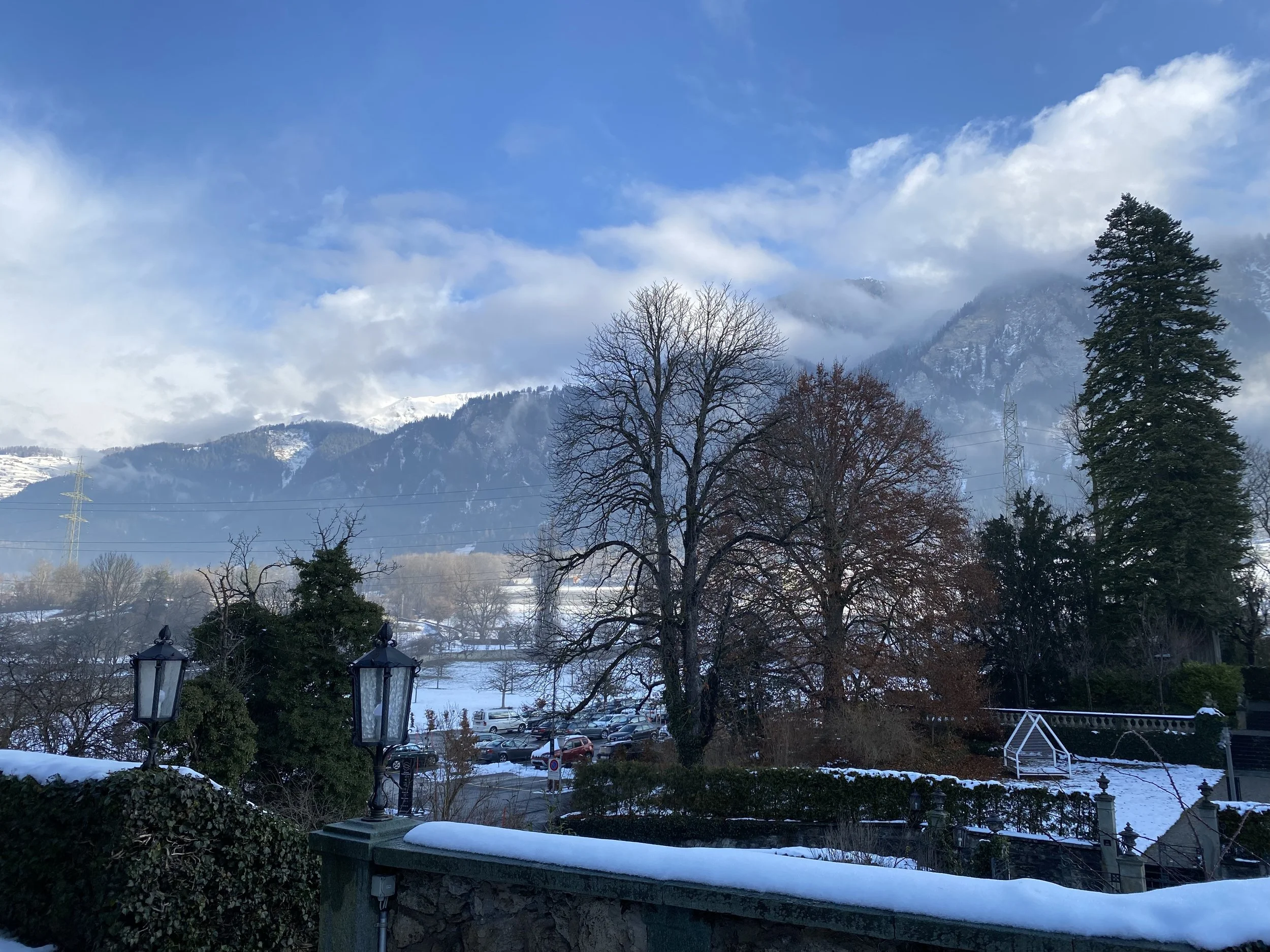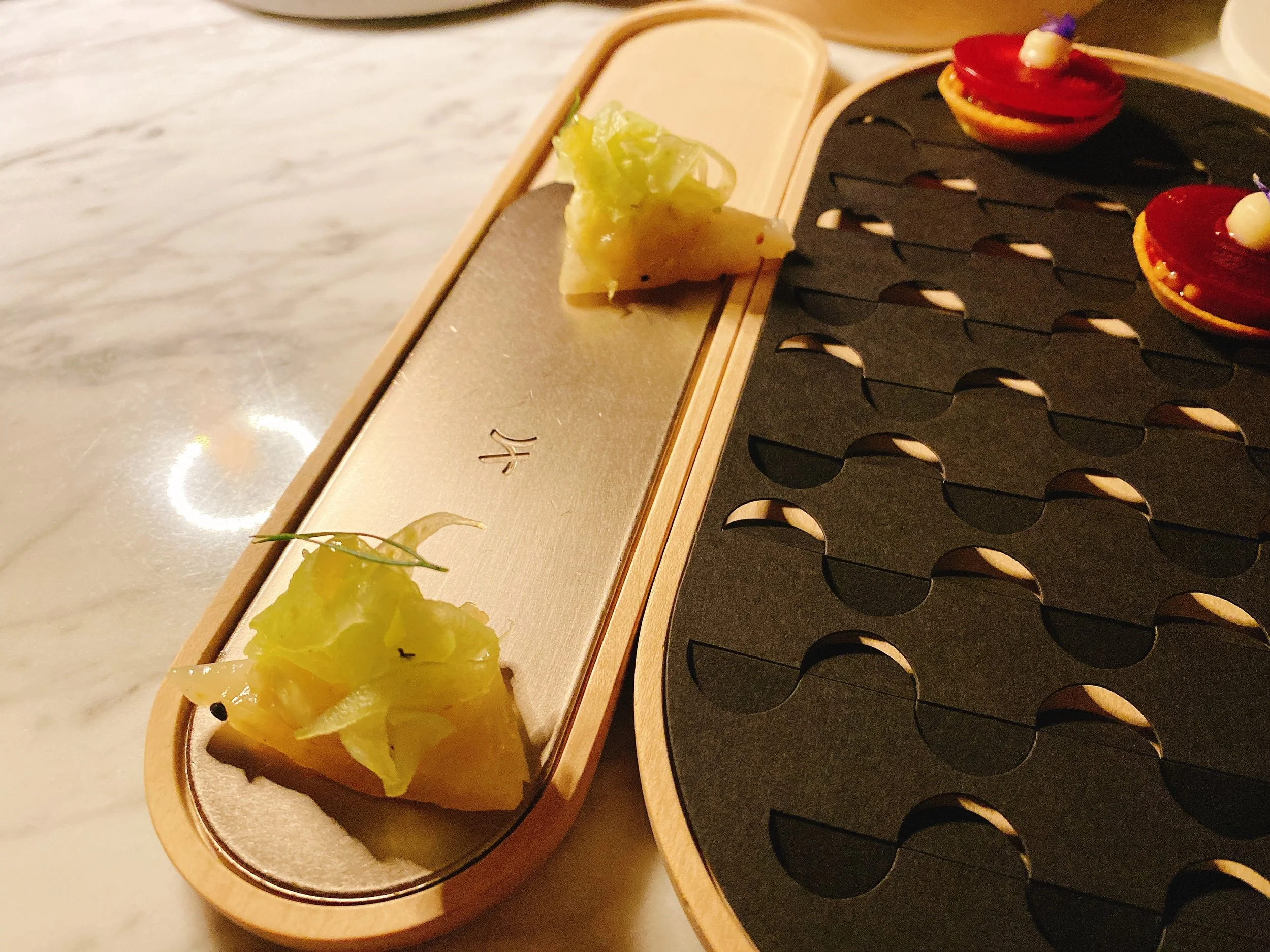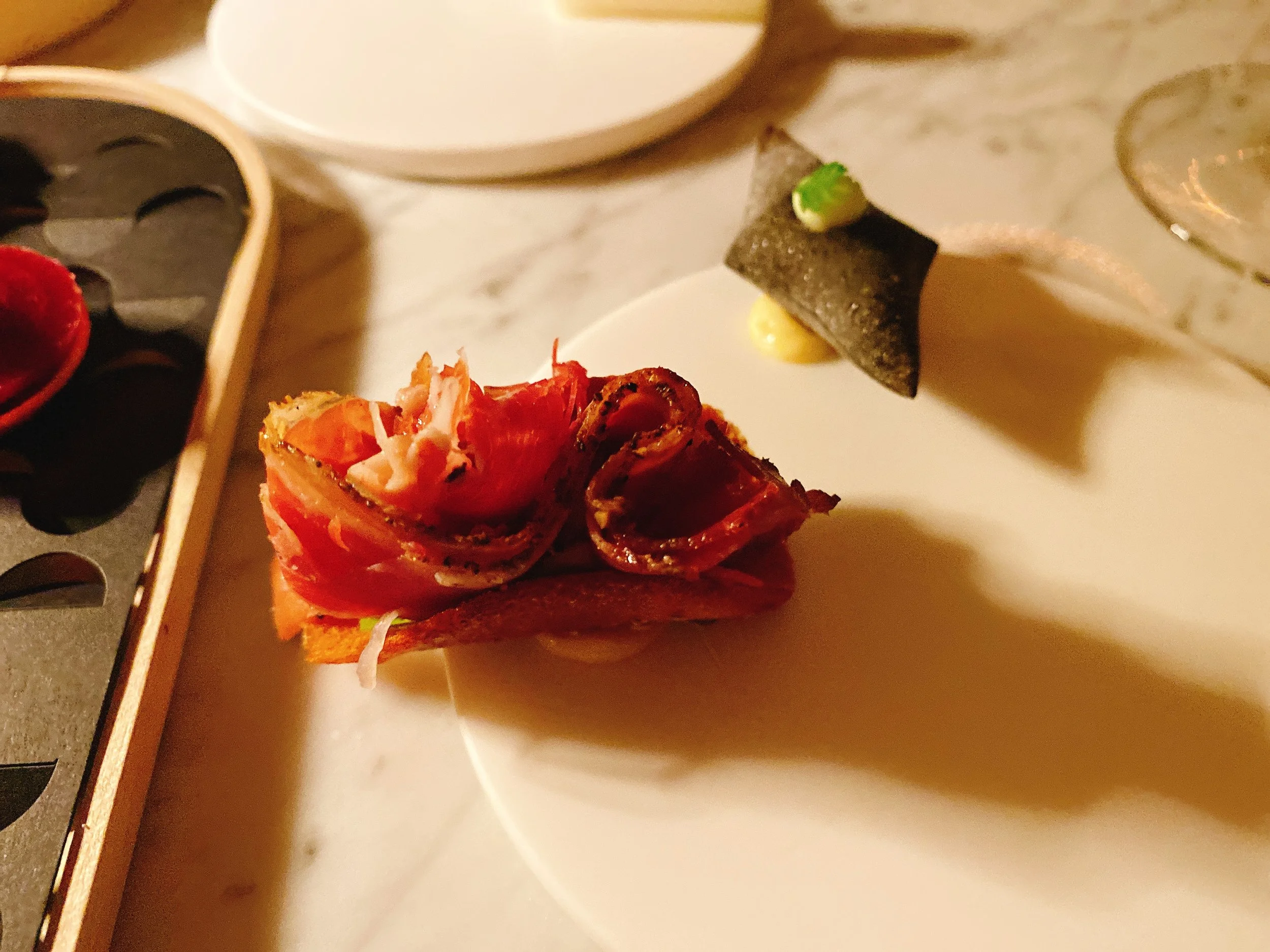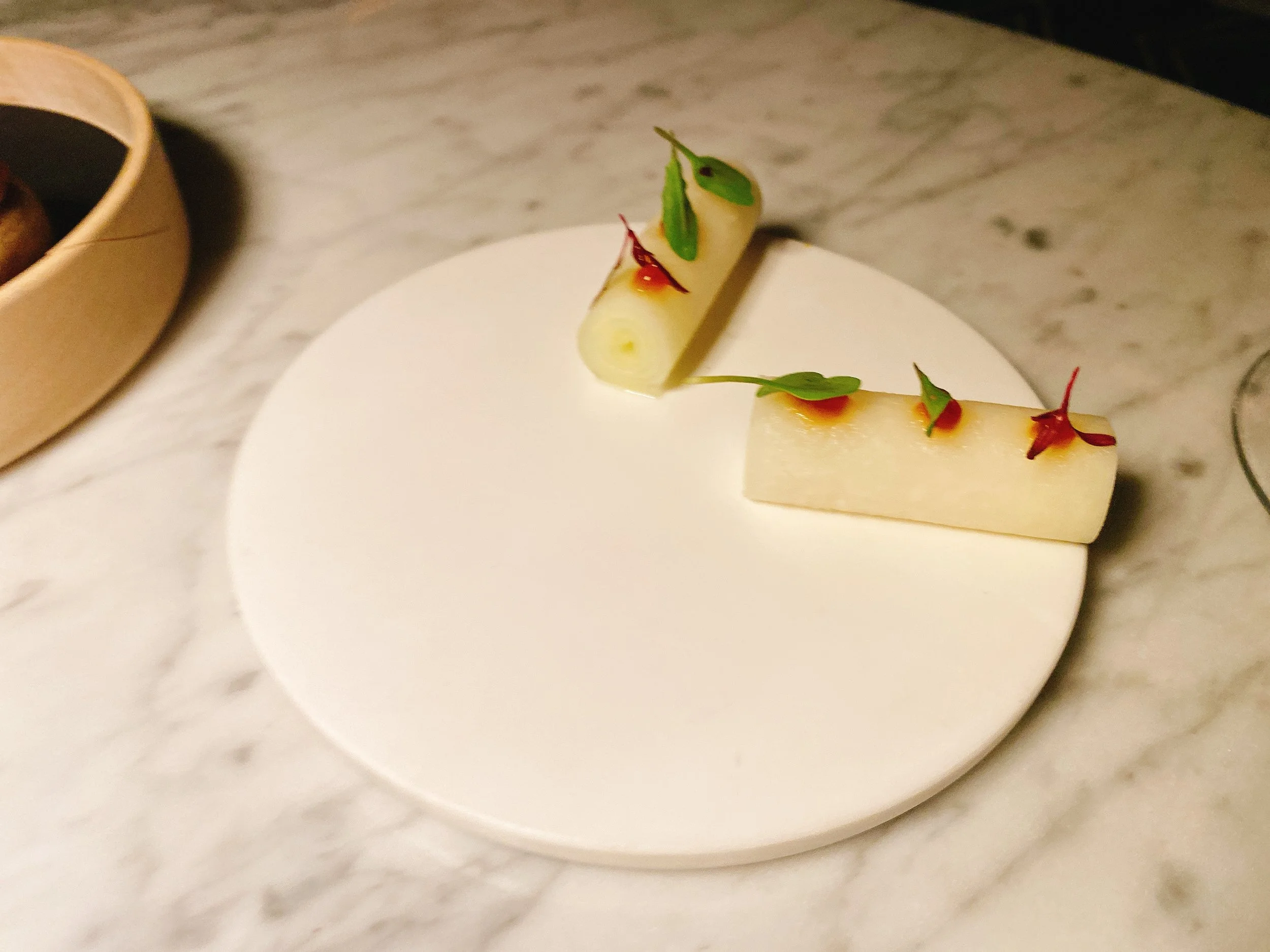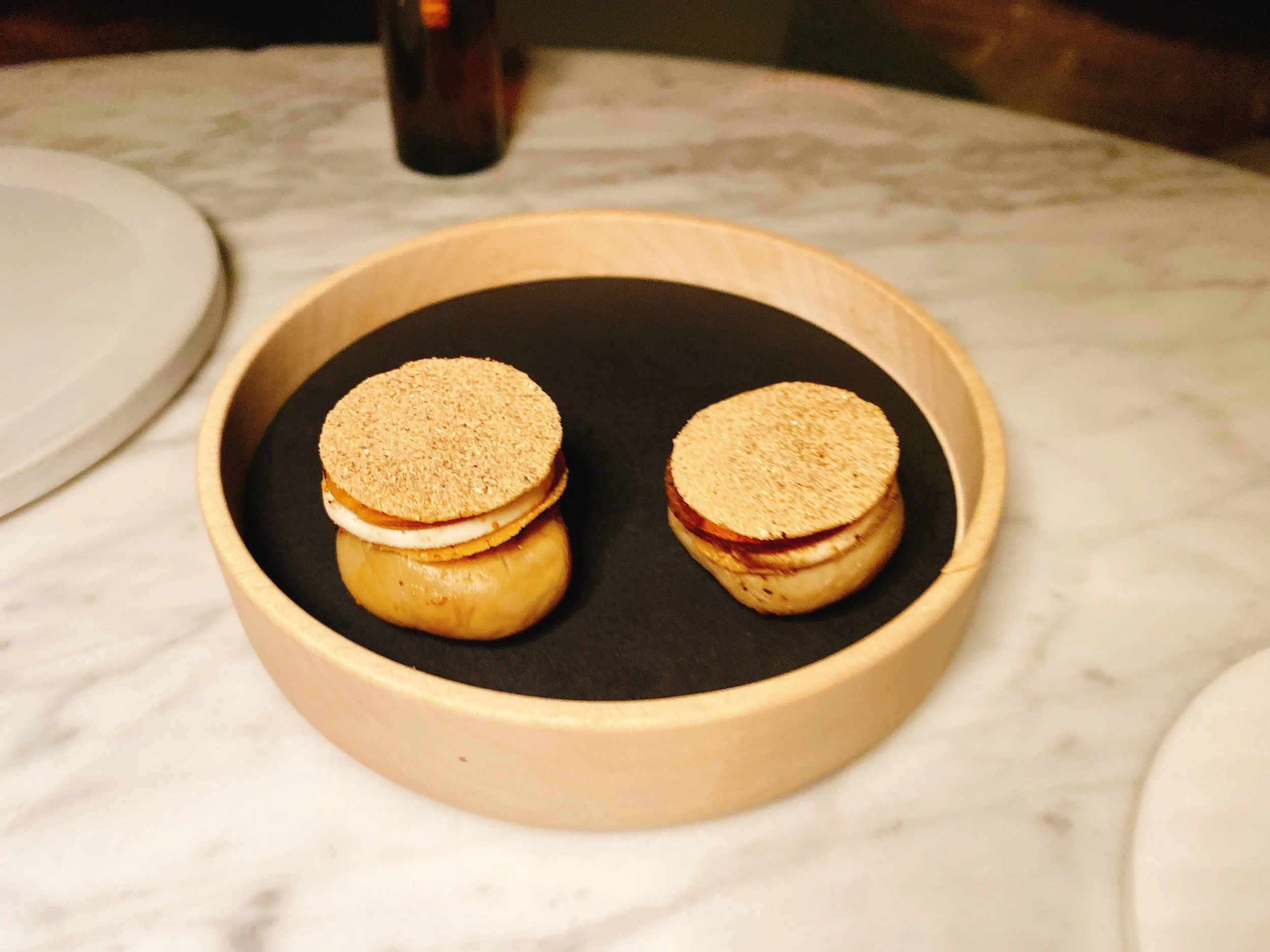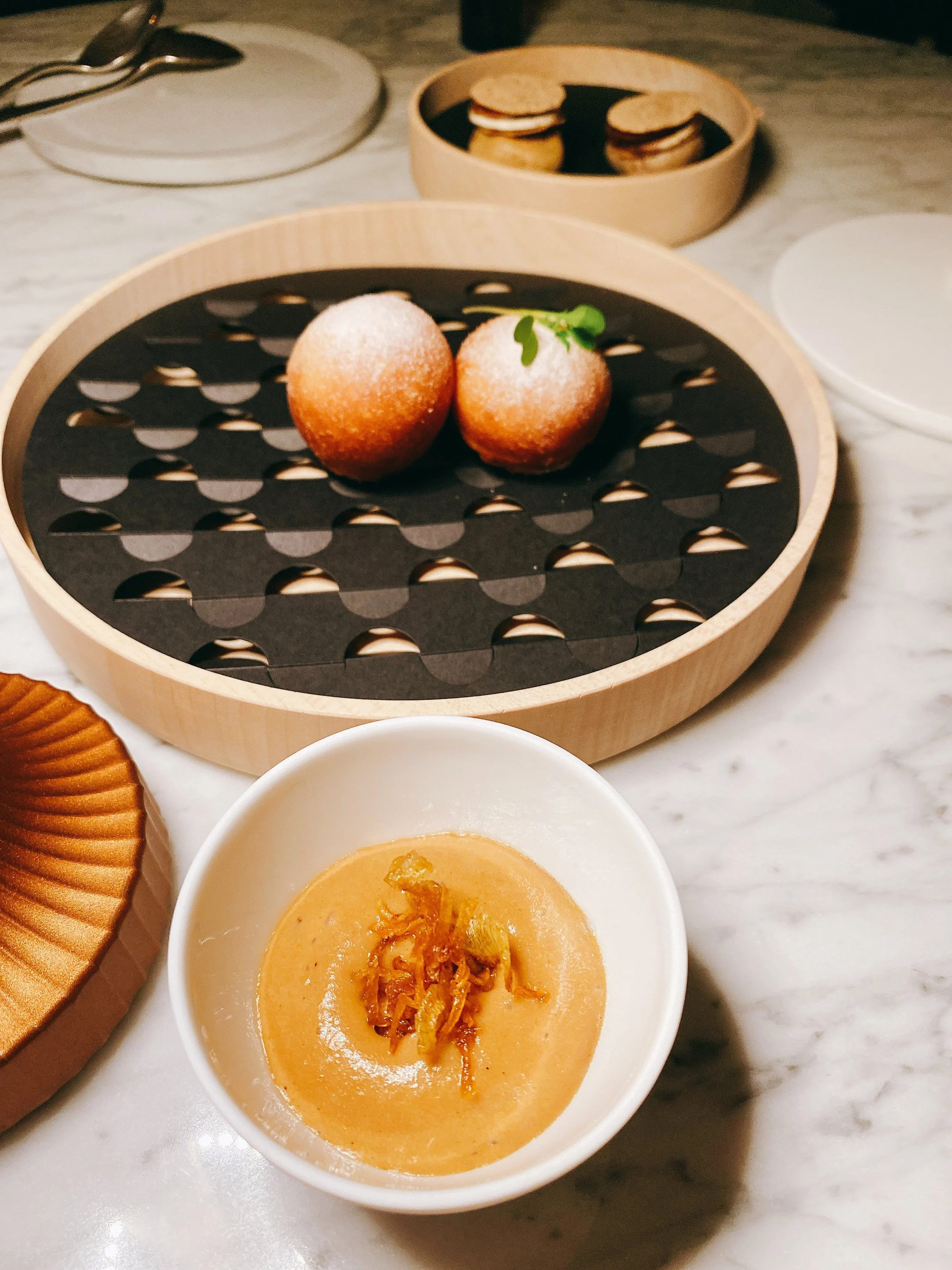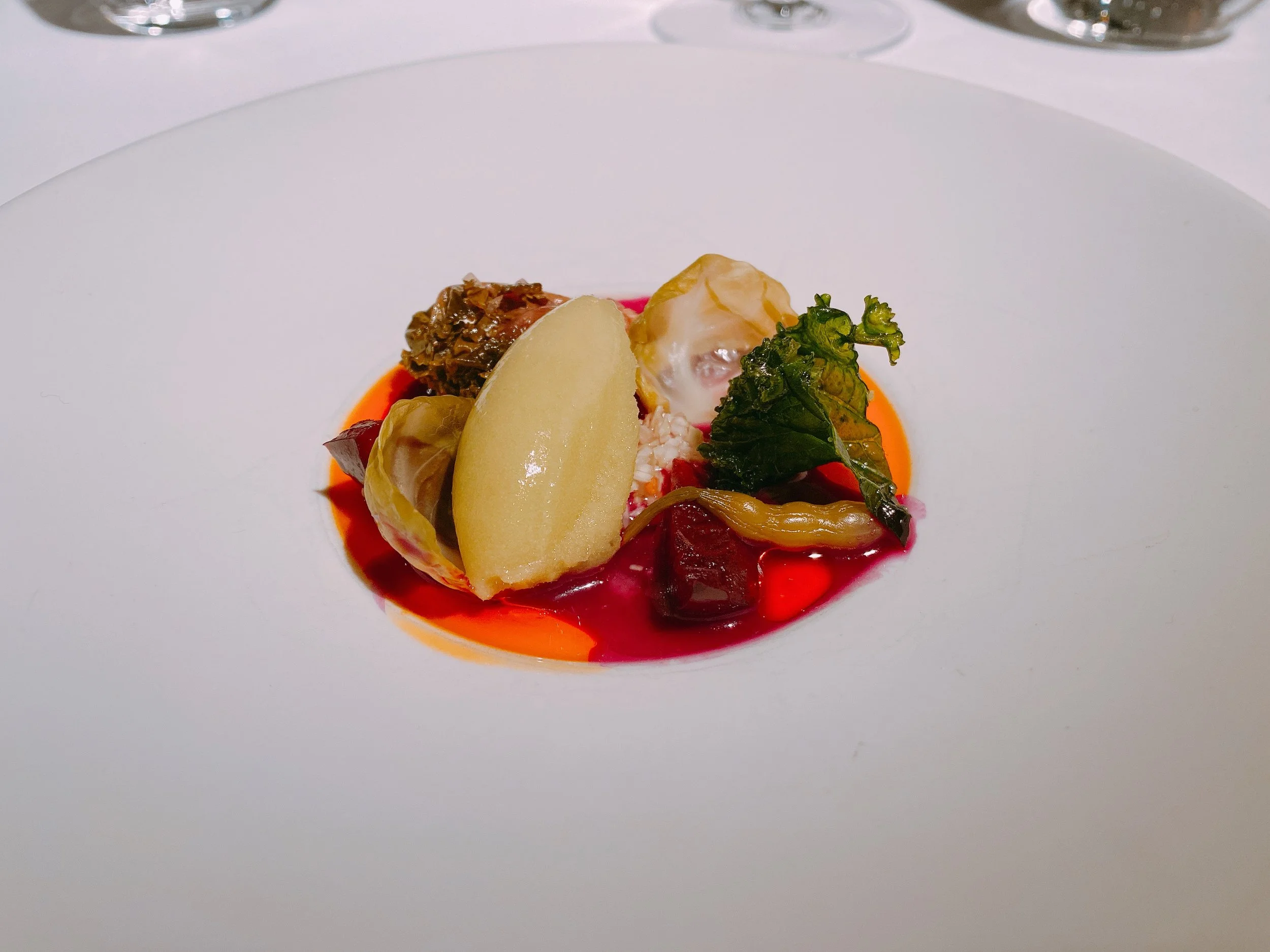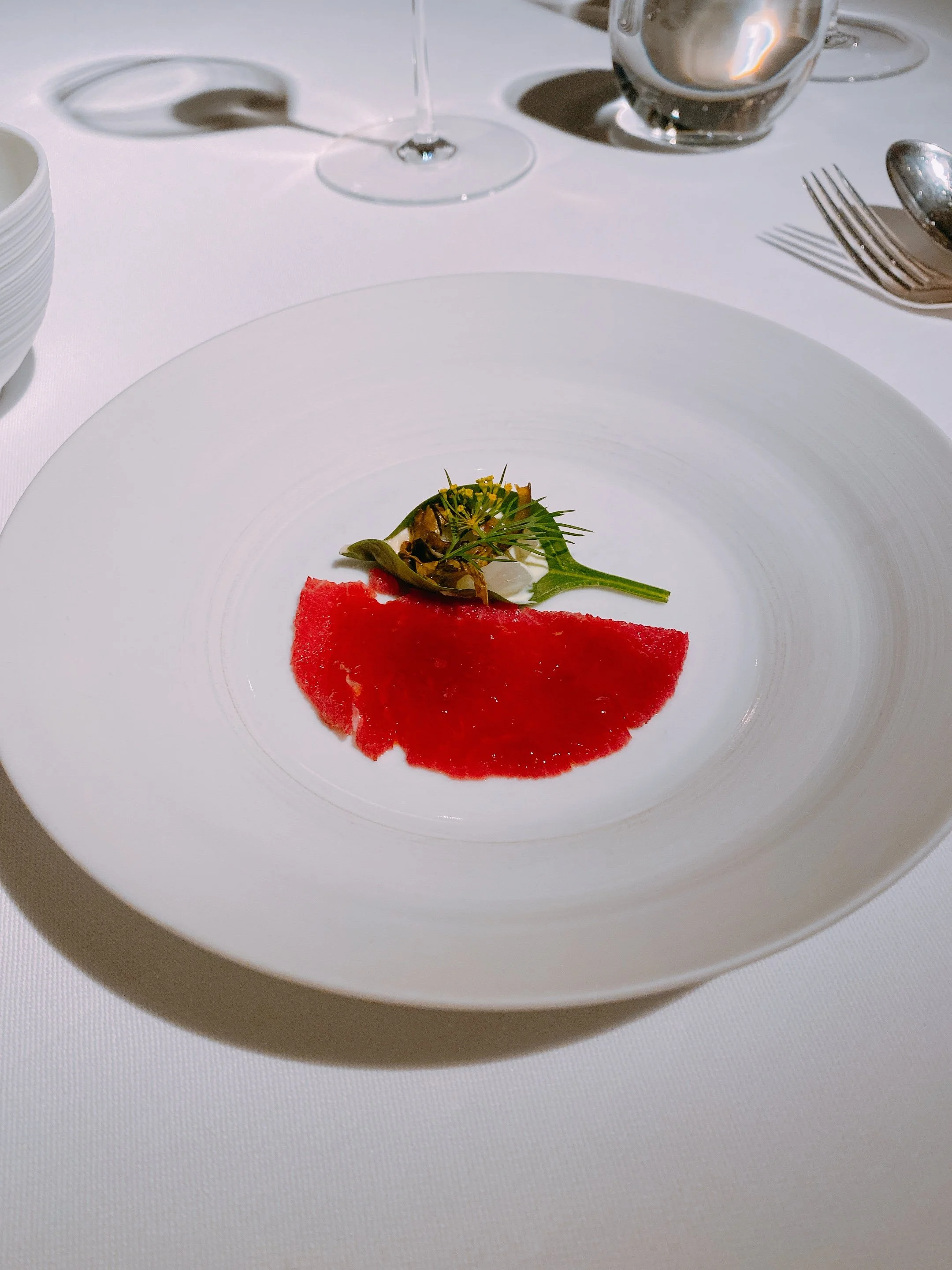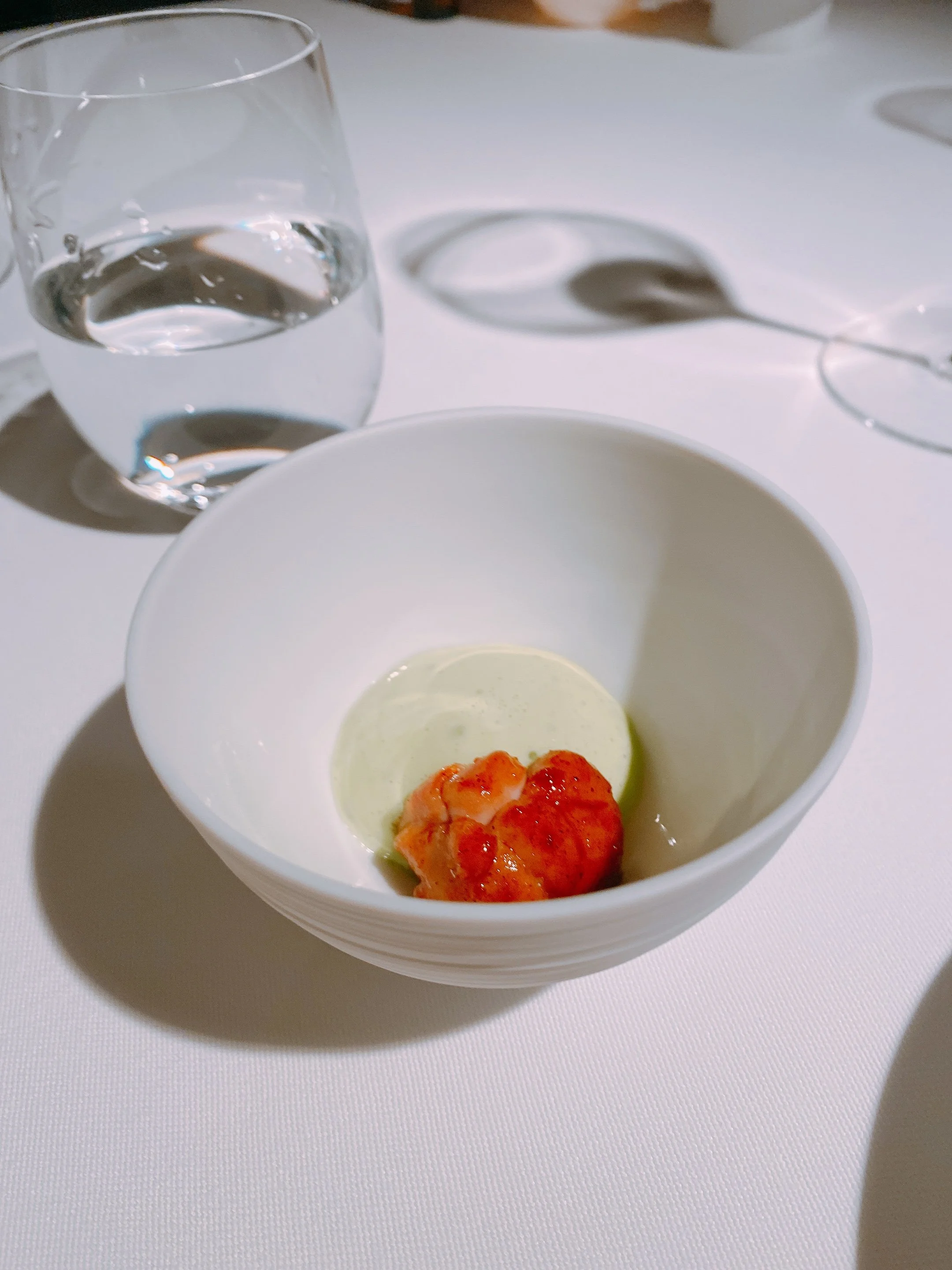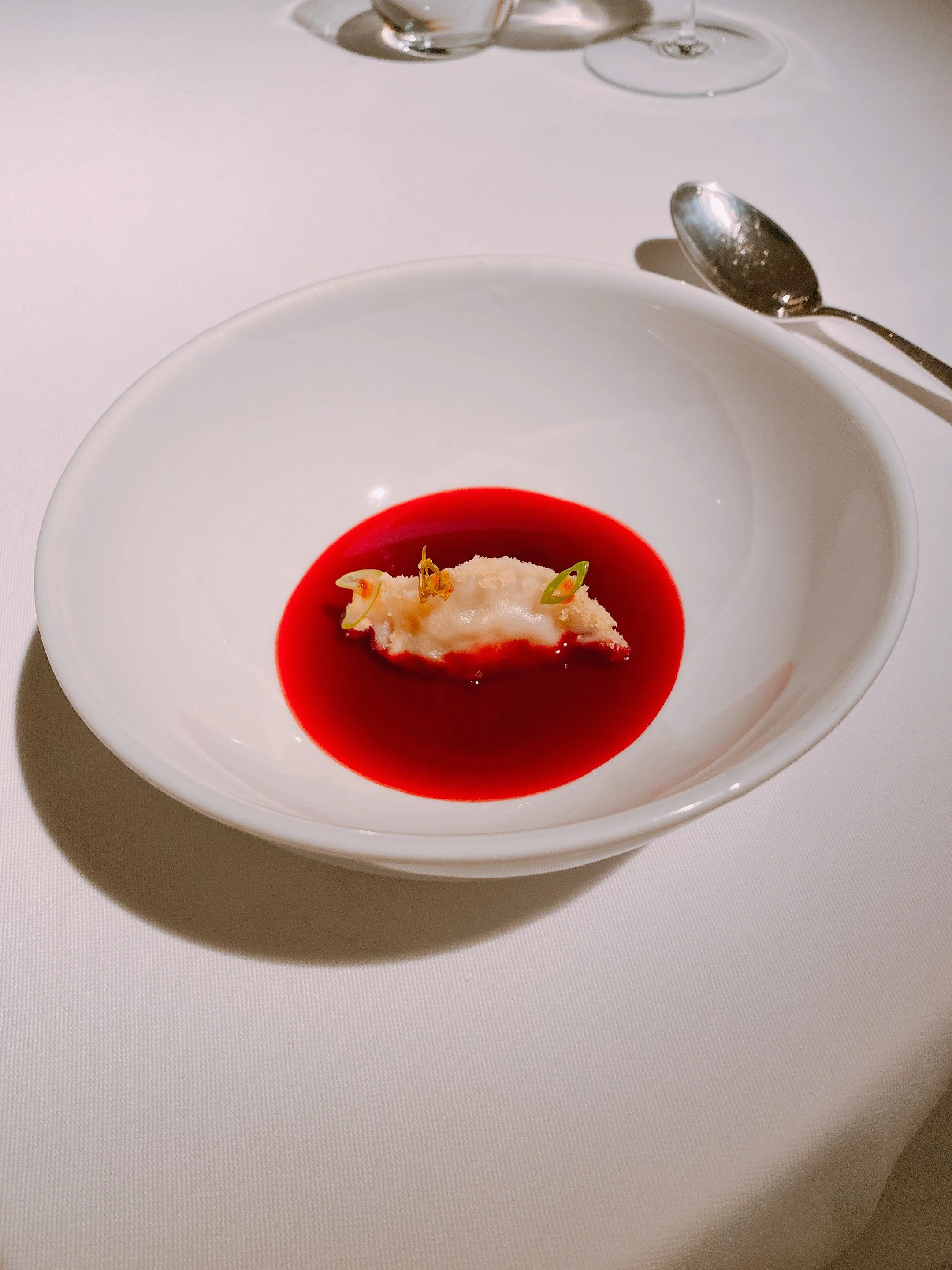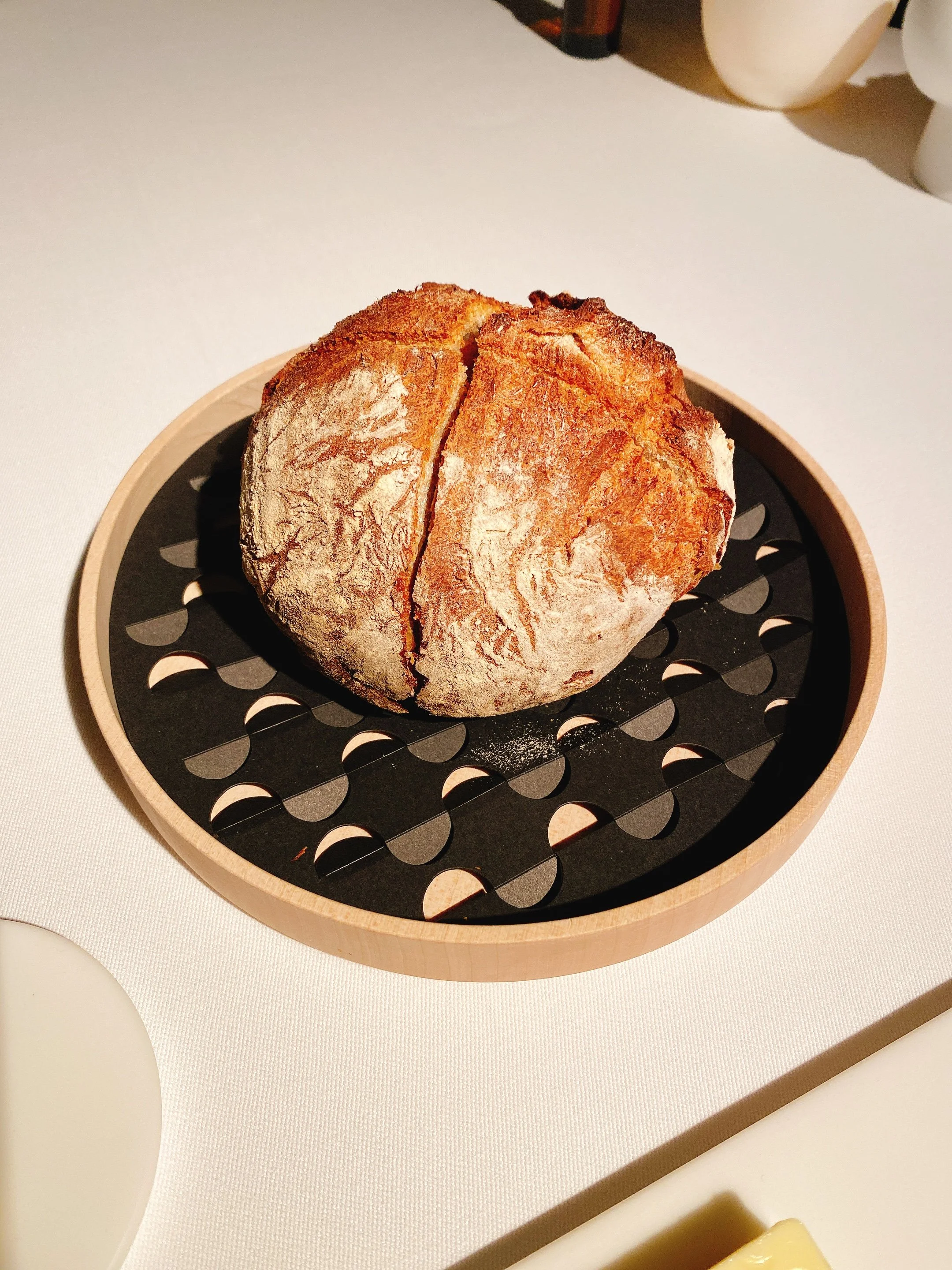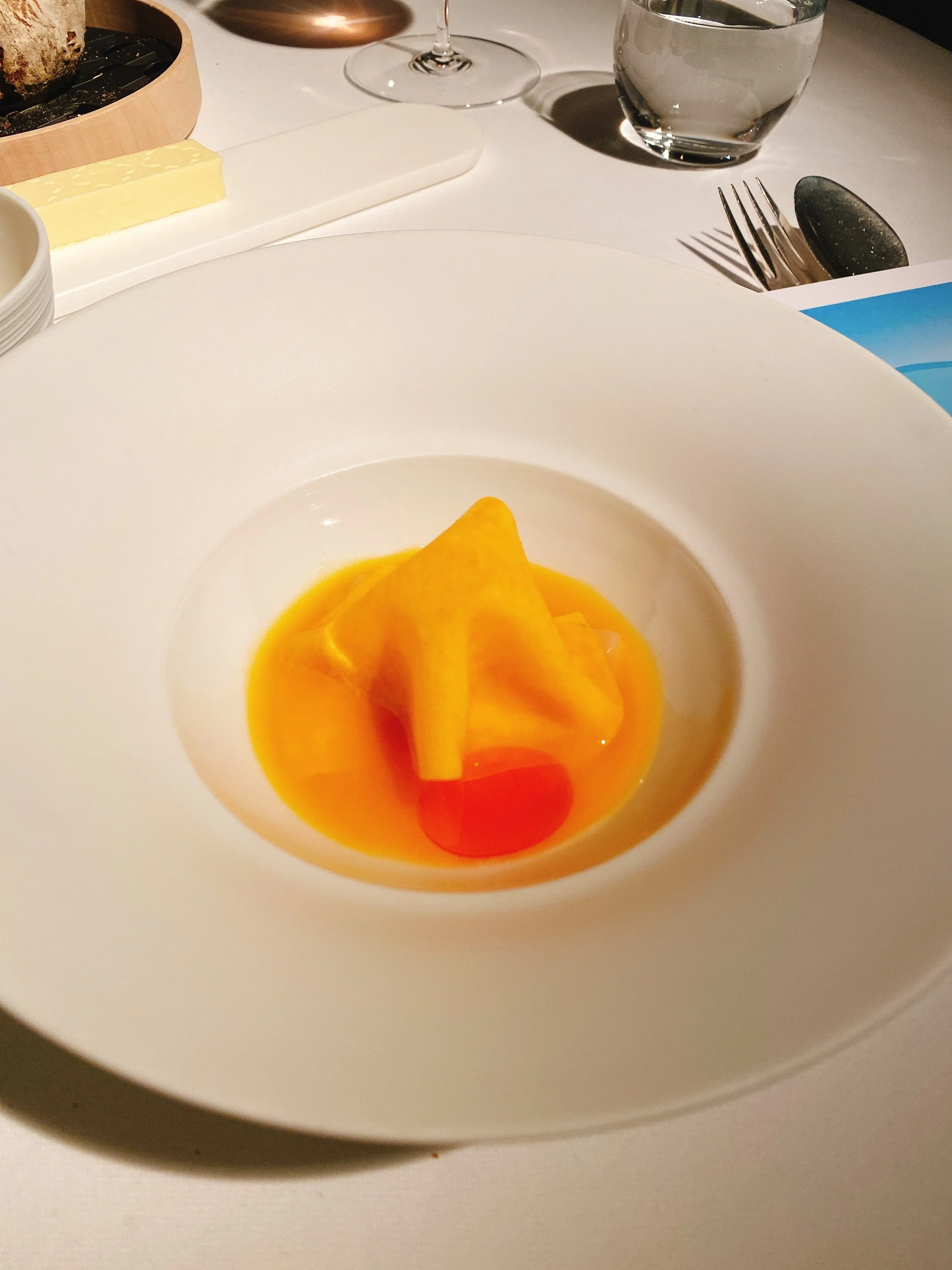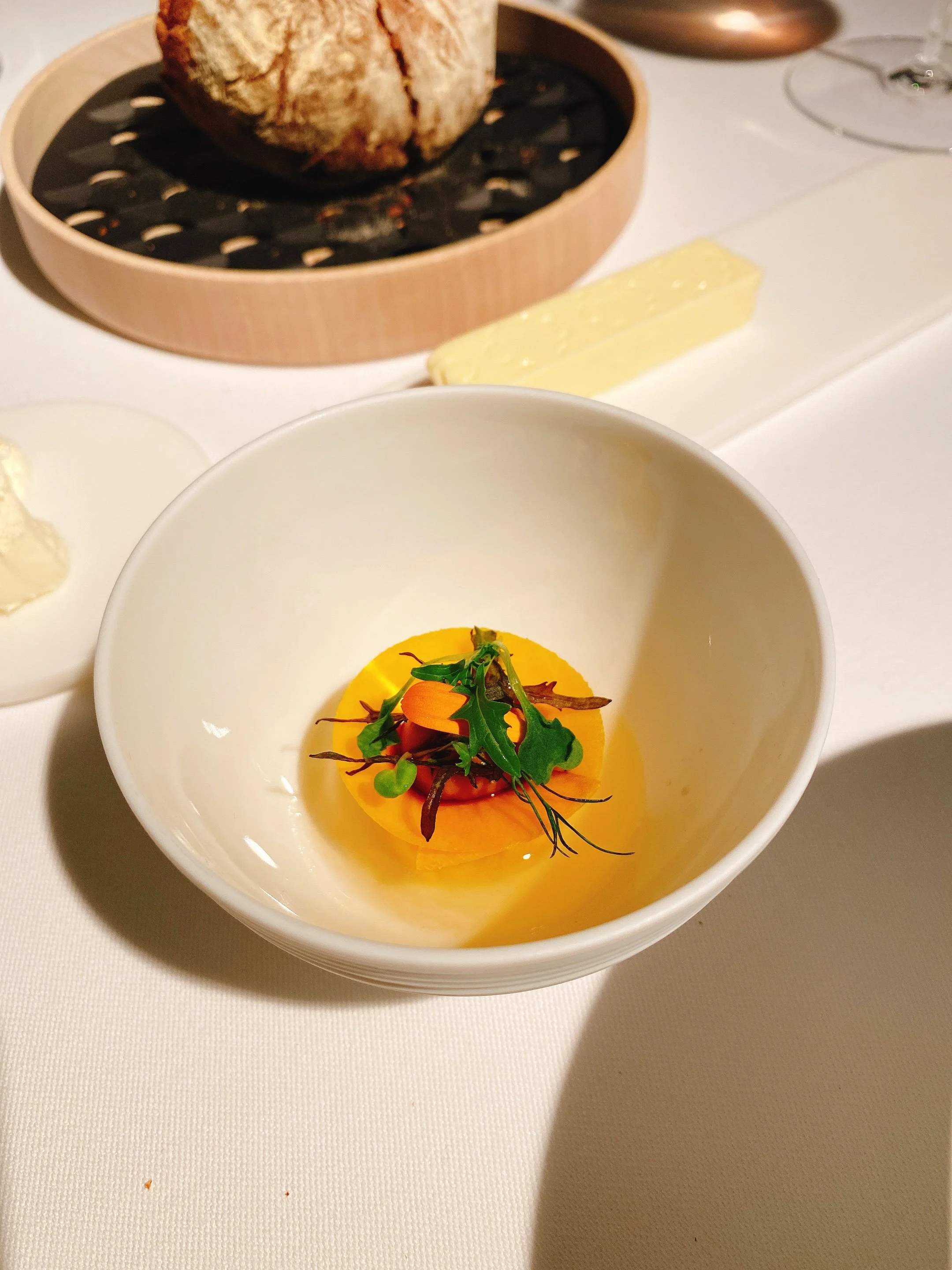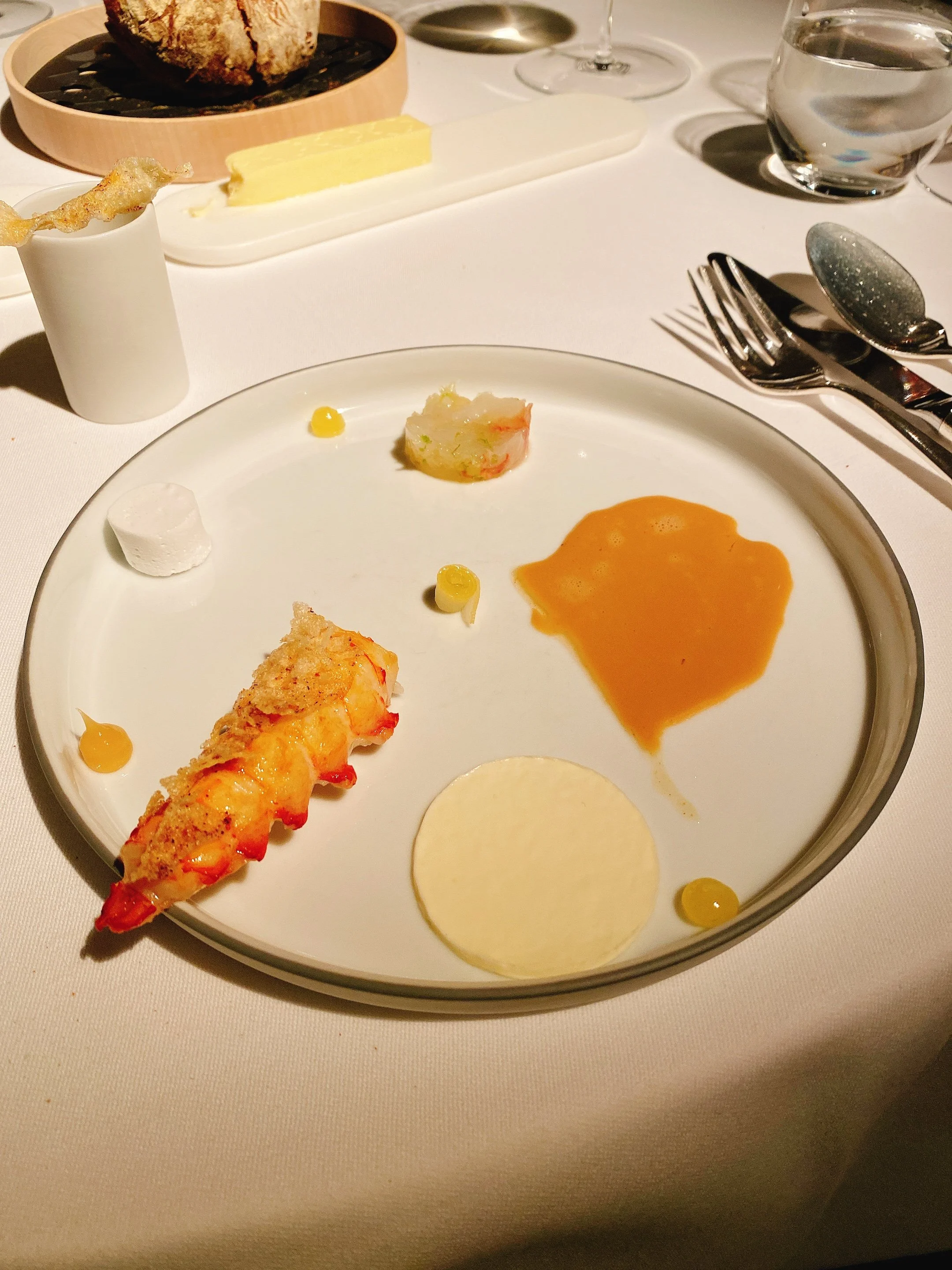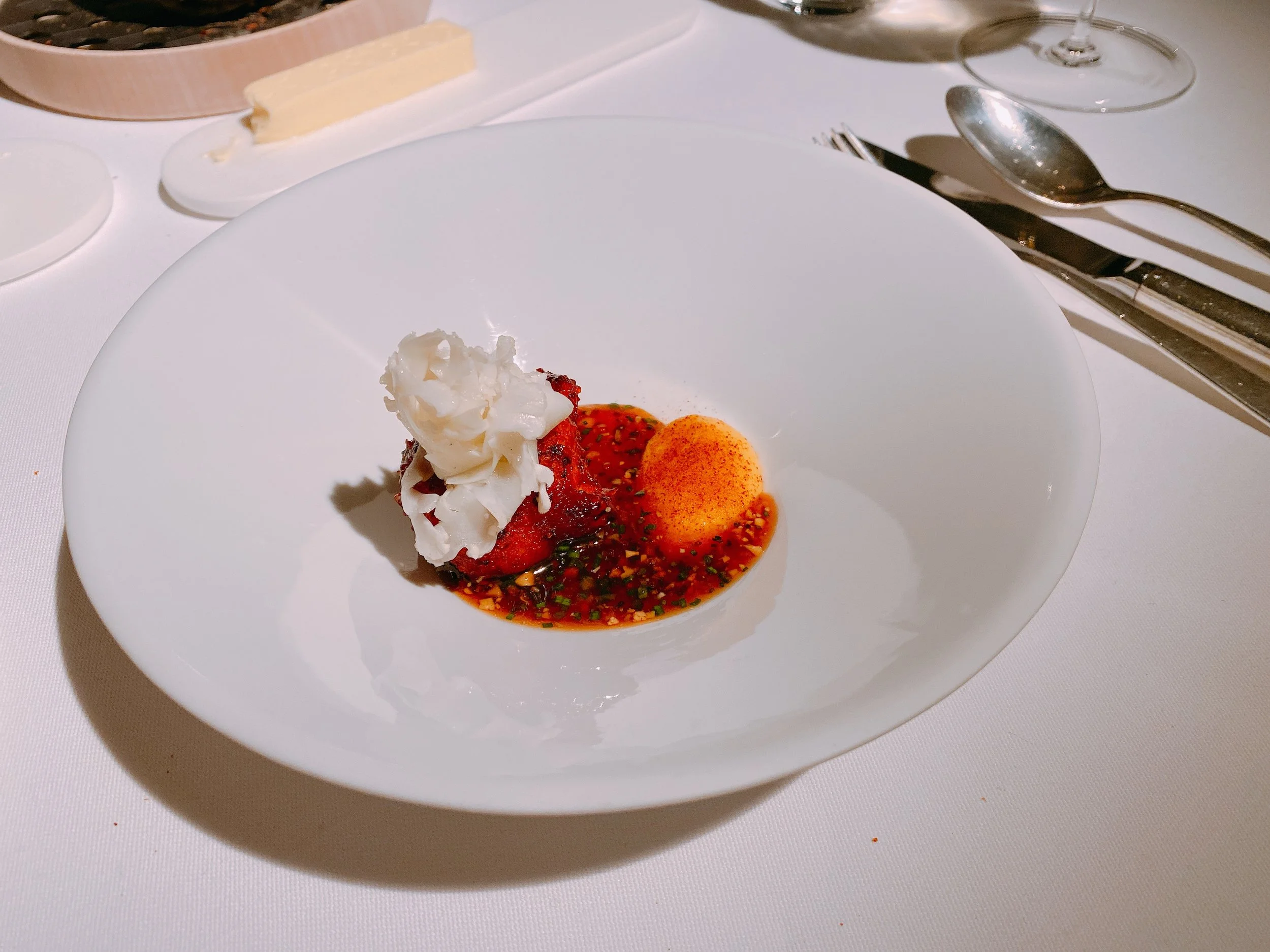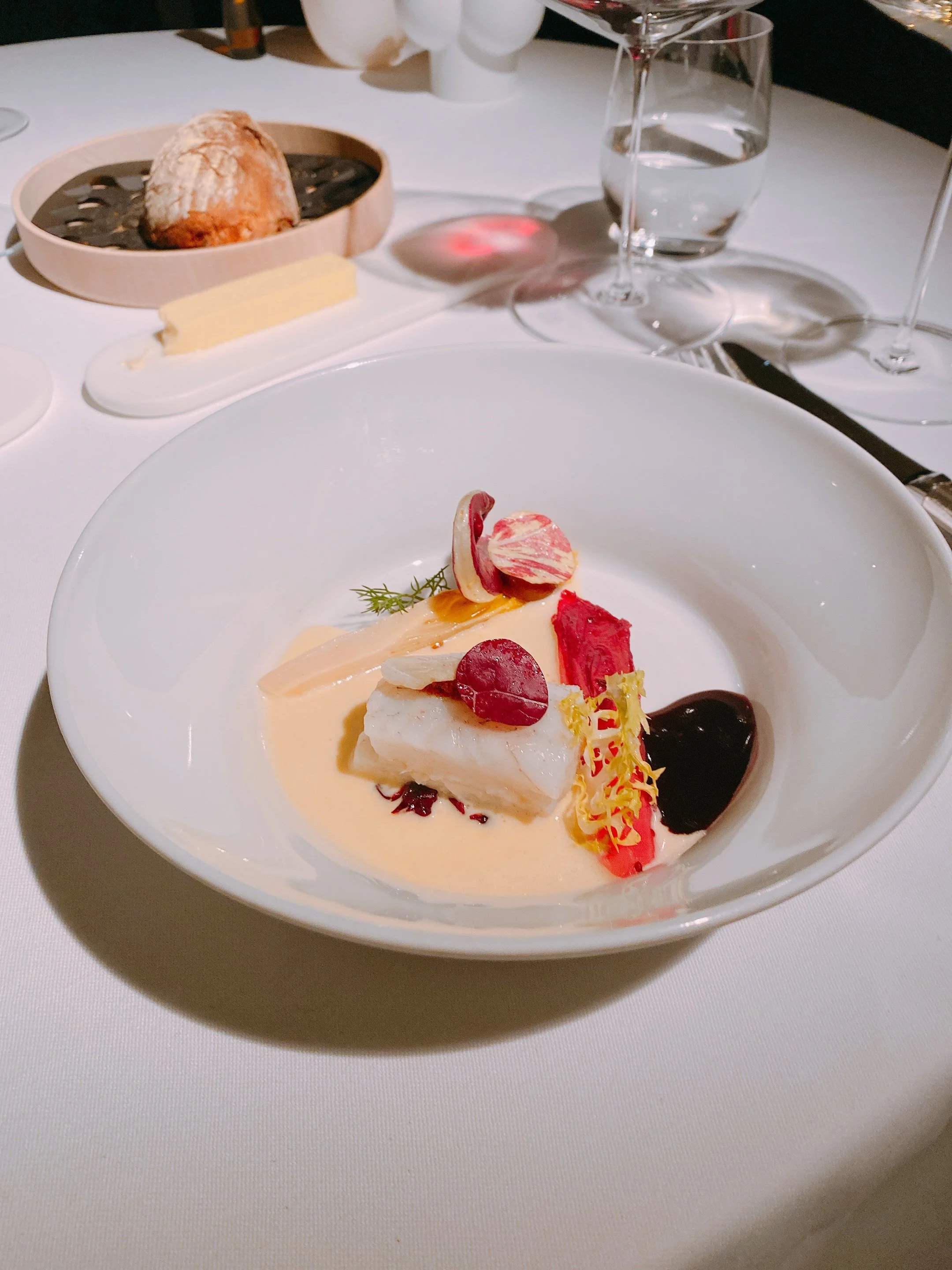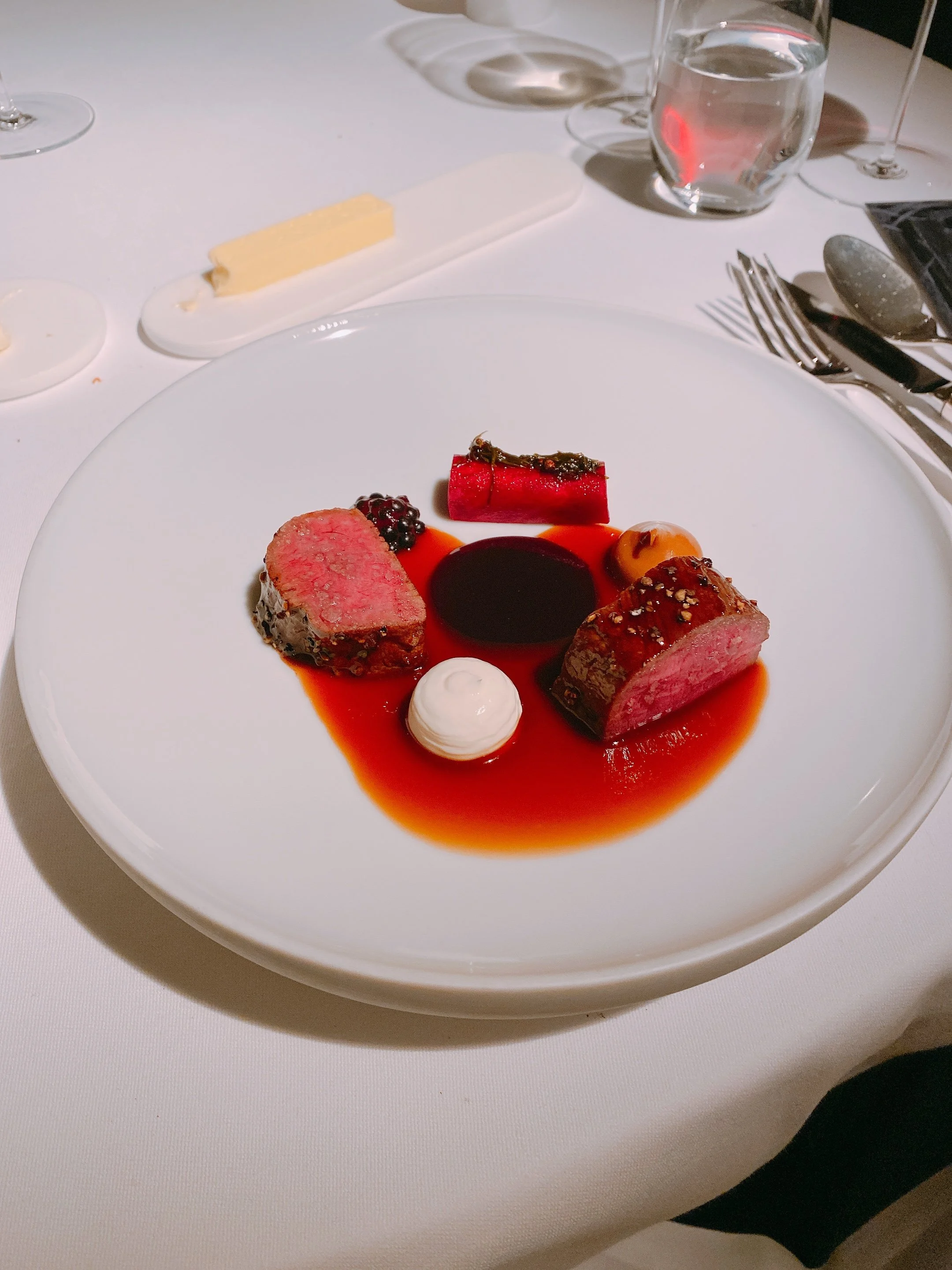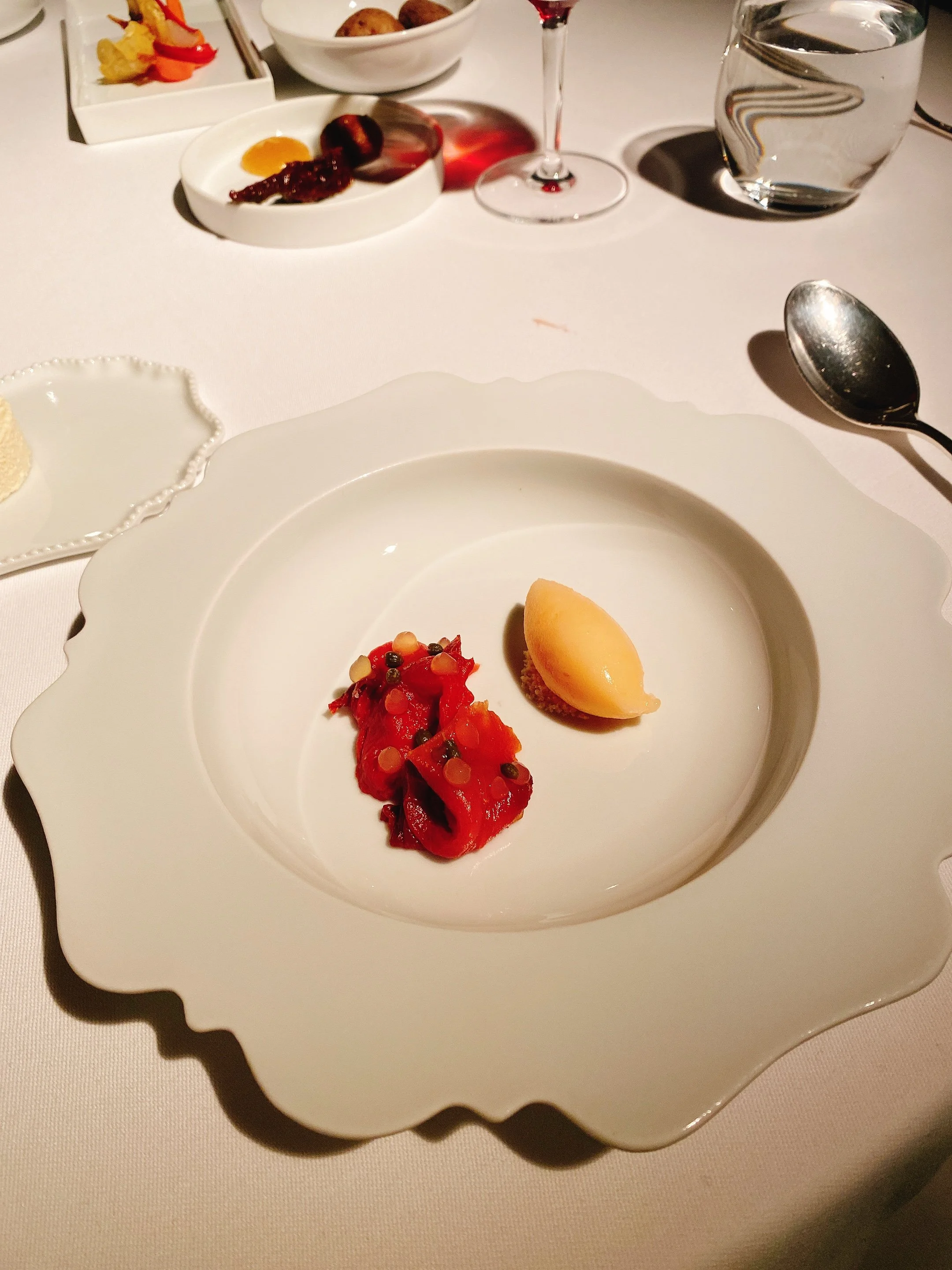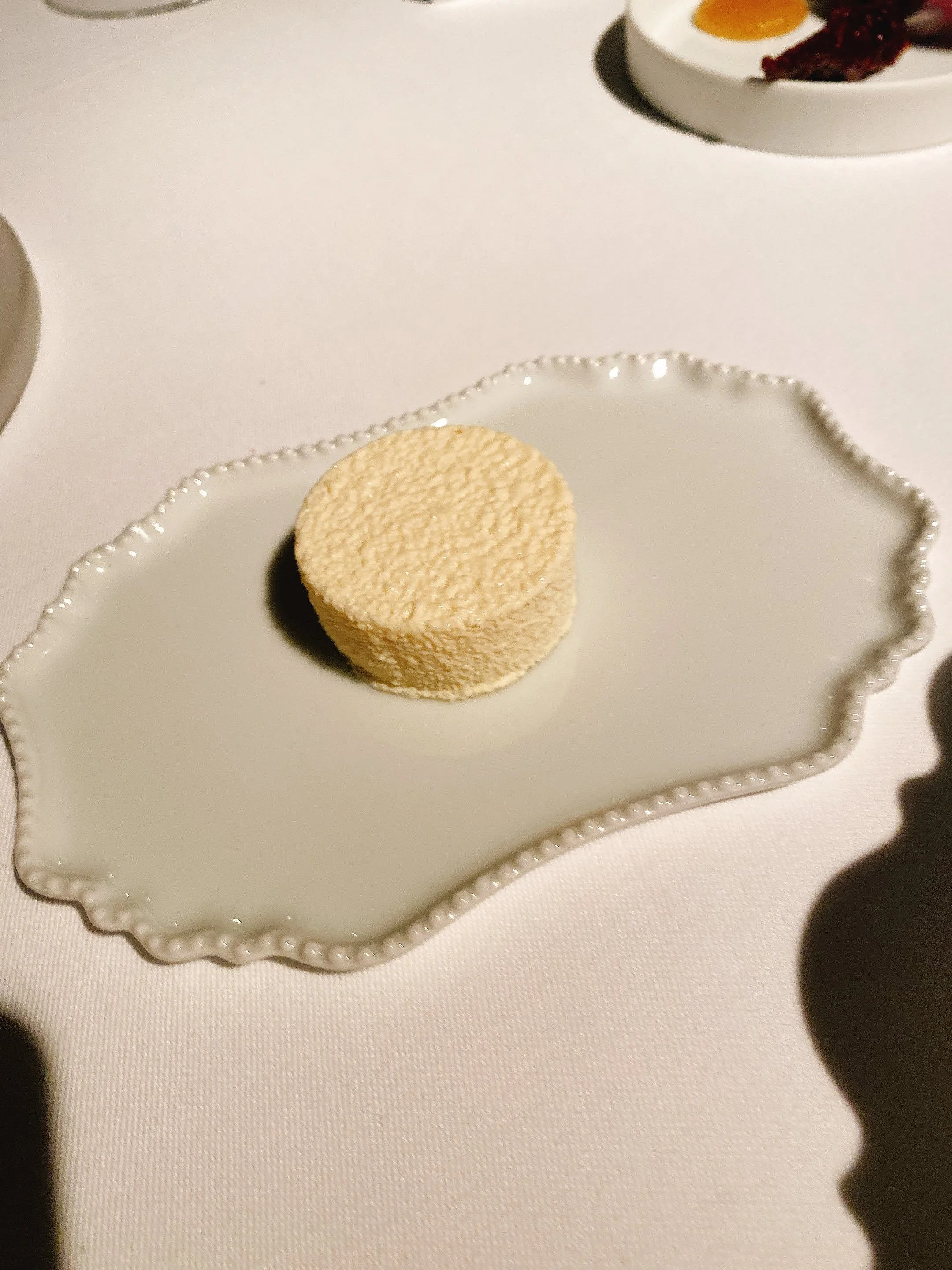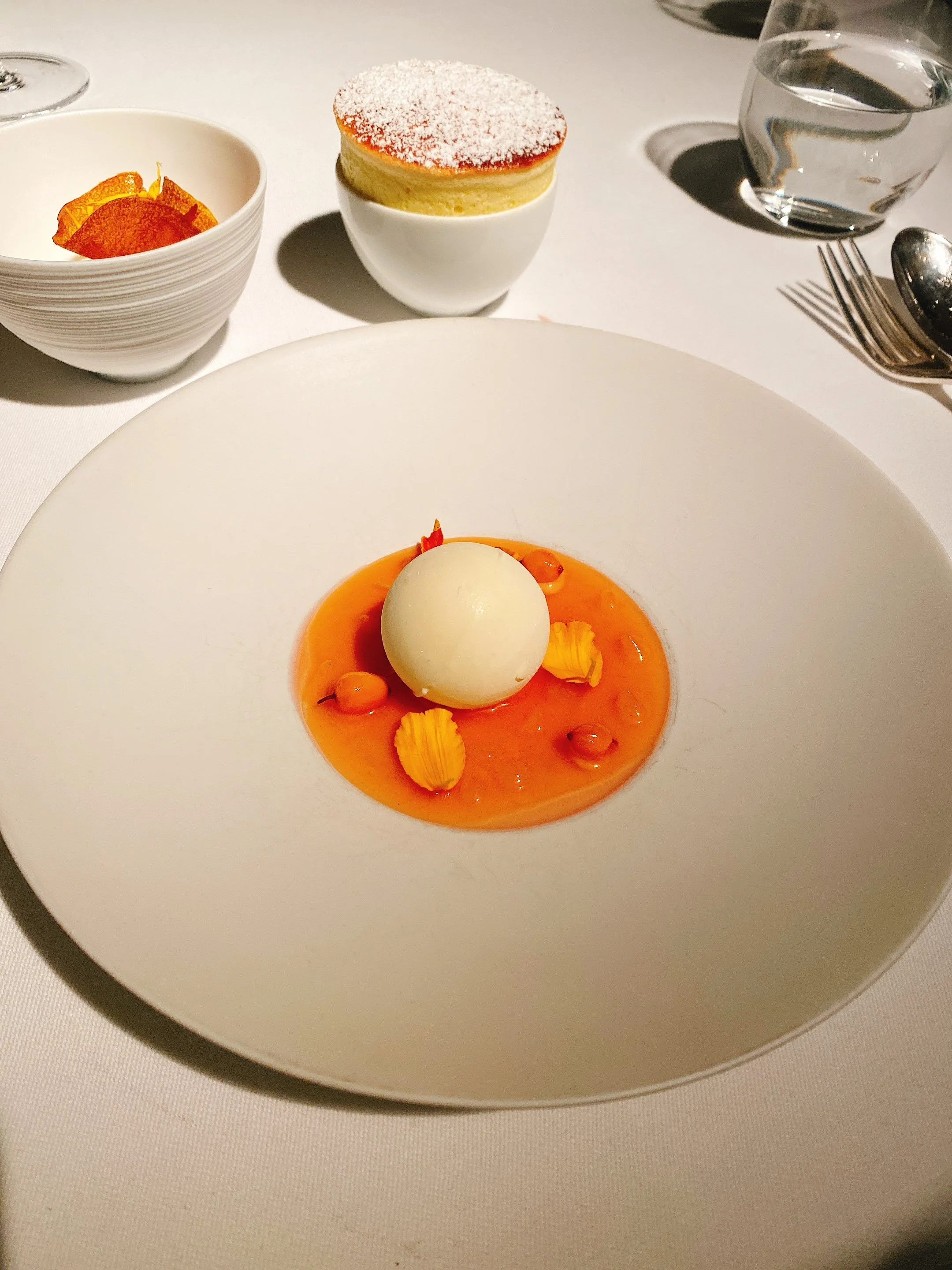Schloss Schauenstein - Fürstenau
Rating: 20/20
Where: Fürstenau, Switzerland
When: Dinner for 2 on 1 December 2021
Cost per Person: Tasting menu 270-335 CHF, Wine pairing 179-214 CHF
Accolades: 3 Michelin Stars, #40 on Top 50 Restaurants list (2022)
Why: Bold flavors, consistently delicious and particularly impressive to use almost all local ingredients
Schloss Schauenstein is located high in the Swiss alps, about a two hour trip south of Zurich. This is truly a restaurant requiring "a special journey" since one is unlikely to come to the "world's smallest town" of Fürstenau by accident. Plus, walk-ins will generally have to walk straight out again - the restaurant is usually booked solid for many months ahead of time. In our case, we "benefited" from a Covid-related cancellation to snag a reservation two weeks ahead of time.
The restaurant is located in a veritable castle, that also houses a hotel; the room we stayed in had quite the quirky layout given that it had to fit into the several hundred year old building. Snacks were provided throughout the day, but we didn't partake due to the big dinner ahead.
Dinner commences with an aperitif (champagne or local wines) in one of the lounges on the third floor of the main building. This is followed by the first set of amuse bouches. These were truly phenomenal. An onion tartlet consisting mostly of a single slice of pickled onion, a bite-sized fennel salad resting on a piece of fennel, a pastrami taco, a pickled kohlrabi bite, and a mushroom tartlet whose base was also a piece of mushroom. Not only were these very, very good 20, but they also served as a introduction of the themes to come:
single ingredients played a big role in each dish (onion, fennel, mushroom, etc), each dish is constructed around one ingredient
flavors are very bold, yet still precise
local ingredients: with very few exceptions all produce was local, so you get a real sense of place; I also appreciate that this provides a reason for the "why" of the dishes
lots of pickled, and acidic dishes. Which I love generally, so no complaints here. I imagine that's partly due to the fact that we went in December, so there is not a lot of fresh local produce available. Makes one want to return in the summer to see how the experience changes.
A beignet filled with spare ribs and a roasted onion mousse hinted at the heavier part of the menu to follow. With the beignet a big doughy and the mousse not as oniony as I would have liked, these were a bit of a letdown after the glorious start 16.
Dinner here is usually a tasting menu, with a choice of anywhere between three and seven courses. It's possible to order classic dishes a la carte as well, but none of the tables around us went for that option. A wine pairing is available as well. We chose the seven course menu, and were promptly escorted to one of the two main dining rooms on the second floor of the castle.
Amuse bouches continued apace - a "cabbage soup" came with sauerkraut sorbet and various kinds of cabbage and kale over a chili oil and red beet sauce. The title "cabbage soup" might make this dish seem pedestrian, but it was glorious - the pickled flavors, and contrasts of hot and cold, spicy and mild, came together wonderfully 20.
Next up: a pickled slice of veal next to a spinach "ravioli", with a side of sweetbreads and wasabi (I think?) mousse. Again, close to perfect, the pickling flavor dominating for the veal, the sweetbreads nicely fried, and the mousse something I couldn't get enough of 20. The pescatarian replacement, a pickled fish, was a bit mealy for my taste, but still pretty good 16.
The following kimchi gyoza with red beet sauce was more of a mixed bag, the gyoza somewhat doughy and the kimchi flavor not very pronounced, but the sauce was out-of-this-world delicious, so we were glad to have a sauce spoon 18.
The final amuse was a "hearty" mini-stew of sauerkraut, bacon and croutons topped by a potato foam. No doubt a nod to more down-to-earth Swiss cooking 18.
Bread came in the form of a wonderful hot loaf, having a perfect crust and a spongy interior perfect for sopping up the sauces to come. We finished the whole loaf over the course of the dinner, and were offered seconds, a nice (but dangerous) touch.
The first official course was trout under a pickled slice of pumpkin. The trout perfectly cooked, the pumpkin savory and its acidity balancing the richness of the trout. A local, seasonally appropriate dish that was also exceptionally delicious 20. It was paired with pickled trout and pumpkin - kind of a reverse of the main dish. I didn't like this quite as much as the main portion of this course, but my wife thought the opposite, so we're clearly splitting hairs at this point.
Next up: langoustine with lemon done two ways. Well, more like five ways: langoustine fried, as a tartare, as a mousse, as a sauce made from its innards, and as a broth. Most preparations came with a lemony flavor. They were accompanied by drops of lemon gels and a tonic marshmallow. The latter I could have done without, but the rest was marvelous: the fried langoustine with its sauce, and the broth just outstanding 20. According to the menu, the langoustine was the only ingredient not from Switzerland on the whole menu (it was from South Africa).
This was followed by what our server declared to be his favorite dish, a battered and fried ball of cauliflower topped with shavings of pickled cauliflower, in a chunky vinaigrette accompanied by a miso mousse. We didn't like this quite as much as the previous dishes, the flavors were not as precise: the fried batter overpowered the cauliflower flavor, and the different components became a mish-mash of flavors overall 16.
The following pike perch with (partially pickled) chicories and beurre blanc was a return to form. Perfectly cooked, a nice contrast between the fatty fish and pickles, and a sauce that I was happy to clean up with the remaining bread 20. The pescatarian menu had this as the following course, and added an eggplant with mole dish instead. Nice, but a step below the dish it was replacing. This was indeed a trend: I felt that the original menu was consistently better than the pescatarian version. The difference was not too big, but it's still worth noting given how often the opposite is true.
Venison with (you guessed it) partially pickled red beets was the final savory course. Wonderfully prepared, not gamey at all, this is about as good as venison gets. It's probably pedantic, but I felt that the explosions and combinations of flavors evident in the earlier dishes were more subdued here, this dish was more "classic" in execution 19. The pescatarian main dish of pike came with a fluffy potato mousse, very delightful.
The cheese course of local cheeses was good (great by US standards), but a step down from comparable offerings in France. Still nice to keep the "local" theme going. Accompaniments were local potatoes, pickled vegetables, some dips and fried dough (supposedly a local specialty, but leaving us a bit nonplussed).
Our first dessert appeared to be red peppers with a pumpkin sorbet, next to a mini cheesecake. The former was interesting (in a good way), and a good transition from savory to sweet 15, but the cheesecake stole the show - it was among the best I've ever had 20. Perfectly paired with a vermouth cocktail that came at this point in the wine pairing. The wine pairing, by the way, was nice, featuring many local wines in addition to an Austrian and a French one, but having no real standouts that I'd want to purchase after.
The final official dessert course were several combinations of fruit and yogurt 16 as well as a phenomenal, perfect souffle 20.
Petit fours were served in the lounge along with coffee, tea or more drinks. These were not particularly remarkable 15, a bit surprising since I read the the chef started out as a dessert chef.
We were definitely full at the end of the meal, and it would have been nice to take a long walk at this point, but it was close to midnight (after a 6:45pm start with the aperitif) and pretty cold, so too bad.
Overall: This was a fantastic dinner, very bold flavors that came together wonderfully. Local ingredients that gave the menu a sense of place and raison d'être. A truly solid three stars. I'd love to come back some other time of the year.
Having been to all three of Switzerland's three Michelin starred restaurants, it is first amazing to see how good all of them are. I think in terms of both average and "lowest" quality of Michelin three stars, Switzerland beats any other country in the world. You can't really go wrong with any of them.
If I had to rank them, it might be Cheval Blanc first, Schauenstein second and Hotel de Ville third (always remembering that even the "last" of these three will still beat the vast majority of three stars in the world). The difference between the first two is small, and mostly due to the fact that Cheval Blanc uses some ingredients (truffles, etc), that Schauenstein due to its local produce theme won't have. So that gives Cheval Blanc a small edge on the wow-factor of dishes, but Schauenstein is the more impressive (technically and intellectually) of the two - showcasing local ingredients and then (even with those limitations) providing an exceptionally tasty and varied menu is truly a magnificent accomplishment 20.
